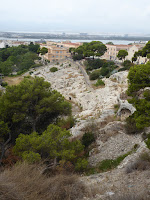Cagliari (pronounced "kah lee ah ree") has been a major Mediterranean trading port for almost 3000 years. Founded by the Phoenicians, conquered by Rome, ruled by Byzantines for 500 years, then Pisans took the town in 1258. Sardinia became part of Spain in the 15th century. Sardinia was finally brought into the Italian Republic in 1861. These influences are apparent in the mixed architecture of Cagliari.
 |
| Cagliari waterfront |
It’s a 15-minute walk from the port to the historic part of Cagliari. The Marina district lies between the waterfront and the old walled town to the north. There is a 19th century Arcade on Via Roma facing the waterfront. Near the waterfront is the impressive Palazzo Civico (city hall). |
| Cagliari Town Hall |
The Marina district has streets that are great for exploring. The Dulcis Pasticeria (pastry shop) is great, the sticky Pan di Sapa is interesting (almonds, honey, orange peel, raisins). Chiesa (church) di Santo Sepolcro’s altar is impressive, and the crypt is quite creepy with a skull and crossbones on the wall.
 |
| Santo Sipolcro altar |
 |
| Santo Sipolcro crypt |
 |
| Santo Sipolcro crypt |
 |
| Porta dei Leoni |
North of the Marina district is the walled city Il Costello (the castle), enter through the Porta dei Leoni and climb to the Bastione di Saint Remy with great views of the city and an impressive arch and stairway down to Piazza Constituzione. The medieval streets are great to explore, with beautiful squares like Piazza Carlo Alberto across from the Cathedral.
 |
| St Remy arch |
 |
| View of Piazza Constituzione |
 |
| Bastion St Remy |
 |
| Cathedral of Santa Maria |
The Cathedral of Santa Maria dates from the 12th century, but was remodeled in the 17th century in baroque architecture. The bell tower dates from the 13th century. There are two pulpits from 1162 that originally were in the cathedral of Pisa but donated Cagliari during Pisan rule in 1312, which now flank the entrance. The crypt is ornate, with the Santuario dei Martiri (Sanctuary of Martyrs). The chapel of San Michele driving devils into hell is noteworthy.
 |
| Santa Maria altar |
 |
| Santa Maria chapel |
 |
| Pisan pulpits |
 |
| Torre dell Elephante |
Caffè Libarium Nostrum is famous for the Alligator drink and views of city. Nearby is the Tour dell' Elephante built in 1307.
 |
| Santa Croce gate |
 |
| Cripta di Santa Restituta |
Exiting the Castle through the Bastione di Santa Croce gate, we went west to visit Cripta di Santa Restituta, which dates from pre-Christian times and was a place of pagan rituals. The 5th century Christian martyr Restituta was imprisoned and tortured here before beheading. In World War II, it was used as a bomb shelter where writings on the wall document the date of Allied arial bombardment in 1942.  |
| Early Christian fresco |
 |
| WWII Allied bombing inscription |
The 2nd century AD Roman amphitheater ruins are still visible, with rows of seats. Gladiators would battle each other and wild animals for the audience. An elaborate canal system would flood the stage area, enabling mock sea battles to be performed.
 |
| Piazza Carlo Alberto |


























No comments:
Post a Comment